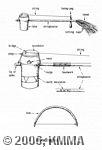
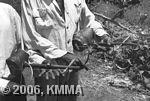
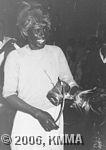
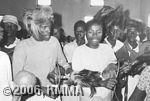
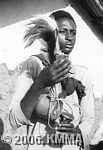
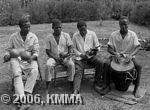



Other names: endingiri, eningiri
The endingidi is a single string fiddle with a cylindrical sound-box or resonator made of wood or cow horn and measuring 15 cm in height and 10 cm in diameter. The Kunta use a gourd for the sound-box. To make a wooden sound-box a suitable piece of wood was first buried in the ground for several weeks to soften it and make it easier to hollow out; a cow horn is hollowed out with a heated knife or a piece of metal.
A piece of hide is stretched over the top of the cylinder and is fixed to the sound-box with wooden pegs, thorny spines or nowadays also with metal nails. The hide used is usually that of the monitor lizard (varanus exanthematicus) but also of young goats and sheep or even of the python. The hide is soaked in water for a whole day before being stretched over the sound-box. The neck consists of a straight wooden stick inserted through the walls of the sound-box at about 2 to 3 cm from the top. At the top of the neck a hole is bored at 4 to 6 cm from the end into which a tuning pin is inserted vertically. The string is secured to this pin is such a way that the string can be wound round the pin in a similar way as with a violin. This allows the string to be tightened, so tuning the instrument. The string runs across the sound-box via a bridge and is fixed to the other end of the neck. The string is made of fibre or animal sinew, but nowadays it is more often of nylon. The arched bow consists of a thin flexible twig, to which a string is attached, usually of the same material as the string of the instrument itself. To give the bow more grip on the string of the instrument, resin is rubbed into the bow string. The resin is often attached to the side of the sound-box so the player can easily rub resin on the bow as he plays.
The instrument is rarely decorated; this is usually due to regional traditions. The sound-box is sometimes decorated with pyrographed designs, the neck with white and blue beads and the end of the neck with a brush of hair from the tail of a goat or a cow. The meat and bones are then removed from the tail, which is then stretched over the neck. As the skin dries, it shrinks and tightens around the neck.
The instrument is tuned in accordance with the range of the singing voices, either by turning the tuning pin or moving the bridge.
The player holds the neck of the instrument in the palm of his left hand as he plays and so can damp the string with the second segment of his index finger, middle finger or ring finger. The hollow sound-box of the endingidi is held against the body and the bow is held in the right hand and is moved very quickly backwards and forwards across the string.
According to ancient sources, the endingidi is not a traditional Ankole instrument but was introduced from Buganda around 1910.
The endingidi player sings as he plays. Among the Iru, the endingidi was usually played solo, but nowadays it is increasingly combined with the engoma drum and rattles. Among the Kooki and the Ziba, two endingidi mostly play together with a drum and rattles and in combination with clapping. Among the Kiga and the Hororo, this ensemble is melodically enriched with the omubanda flute.
The endingidi is played by men when they play music for relaxation and the common thread in the lyrics of the songs is social life. The endingidi also used to be played in ritual music and at weddings.
for more information see also: VAN THIEL, Paul, "Multi-Tribal Music of Ankole. An ethnomusicological study including a glossary of musical terms." Edited by the Royal Museum for Central Africa, Annales, Sciences Humaines, nr 91, 1977, 234 pp.
© KMMA/Paul VAN THIEL